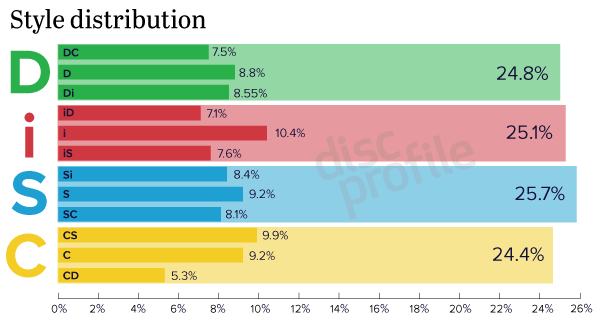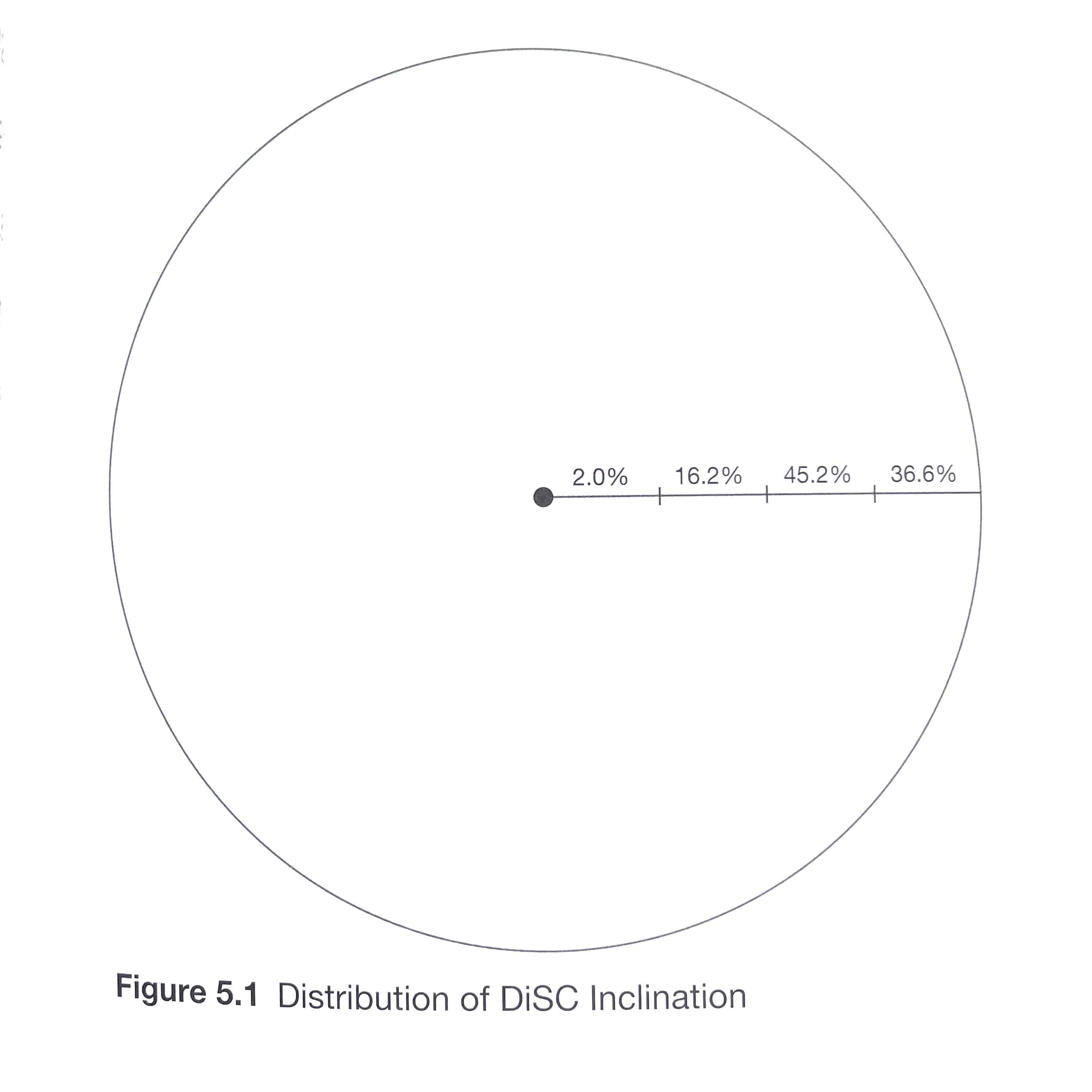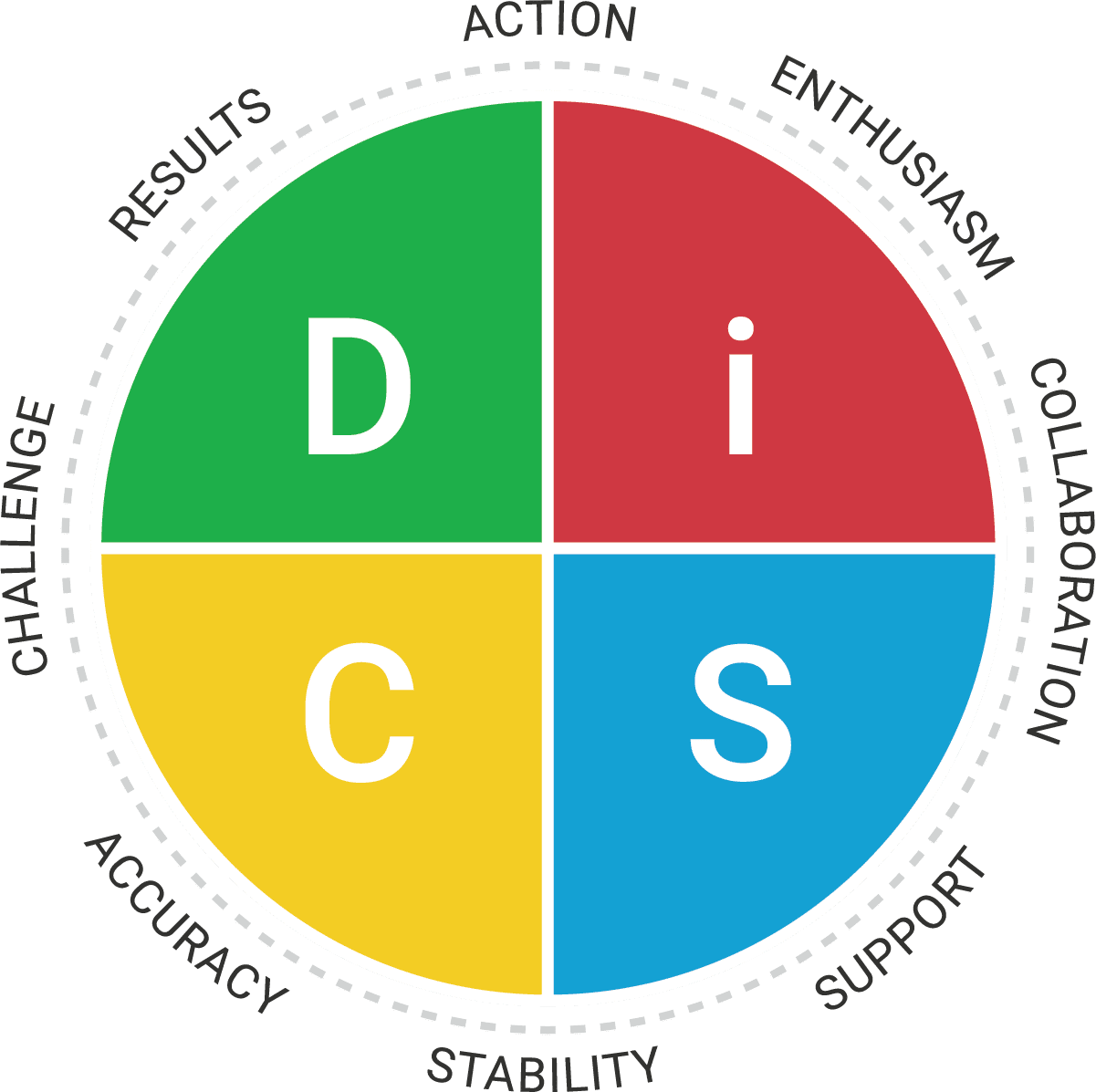How can I use knowledge of DiSC® styles?
There are many ways people use DiSC®. Here are a few:
- tailor communication to match the preferences of the recipient(s)
- discover better ways to motivate others
- reward others in ways that matter most to them
- engage in more productive conflicts
- increase emotional agility
- provide better customer service
- build better relationships at work and in the community
- onboard new employees more successfully
As an example, I like to review DiSC styles when preparing for a presentation. It gives me an idea of what my strengths will be (strict standards, resolute approach) and it also cautions me to watch myself for being overly blunt or critical. I look at other profiles and know that I need to project a warmer personality and maybe insert a personal story if I want to reach more of my audience.
What’s the most common or rarest DiSC style?
There are no style “outliers” in the DiSC model refined by psychometricians at Wiley. Everything DiSC® assessments are normed so roughly a quarter of the population falls into each quadrant.

Other assessments based on the DISC model might show a predominance of one style because their assessments haven’t been normed for equal distribution or because their questionnaire items are value-laden, using terms for one style that are more socially desirable than others.
Can I have one style at work and another at home?
Most people have a similar style at home and at work. Efforts to validate the measurement of these separate parts of one’s self in an instrument have not been successful from a research perspective. That’s why you don’t see an adaptive style in any Everything DiSC profile.
Nevertheless, this is a common question. We may act more from one style than another because of need. If you’re caring for an elderly parent in your home, you are likely calling upon the S style. If you’re leading a new project at work, you’re likely using D-style behaviors. But this doesn’t make you an S style at home and a D style at work.
Consider how much energy it takes to conduct your activities at home and at work. It’s always possible for us to stretch into different styles, but it takes extra energy. It can even be stressful. Learn more about the DiSC concept of stretch.
Can my DiSC profile change over time?
In general, the average person’s profile tends to stay fairly consistent over time. While small differences in results from one time to the next may occur, major shifts in style are unlikely.
If you’ve experienced a major life event, it’s possible that your style could change. If you’ve been called upon to use behaviors typical of another style, you may become more comfortable with them, and that can also impact the way you respond to the assessment. However, the change is usually slight. The placement of your dot might move closer to the middle, or from the D to the Di area, for example.
Can my DiSC predict what jobs I might be best at?
Everything DiSC has not been validated as a hiring tool. There’s no strong relationship between DiSC style and job success. Nor is there one DiSC style that’s best suited for a job type. Both job satisfaction and success are determined by many factors in addition to the personality traits DiSC measures.
However, some jobs do have a disproportional number of people with similar styles. This is only a modest trend and may only indicate that more people choose or are hired for that profession. For example, you might see several iD styles in your sales department. That might mean more iD styles go into sales or that your hiring agents have a bias toward that style for sales. For more details see the Everything DiSC Manual.
What is the ideal DiSC profile?
There is no ideal DiSC style or type. Each of us has our strengths and our challenges. DiSC doesn’t tell us if we’re skilled at various behaviors, but rather how much effort it might take us to enact them. Each style can be used in a positive way or overused to our detriment. DiSC reminds us that we’re all a blend of all styles and capable of stretching into other styles as needed.
Which DiSC profile is best?
The best profile is the one that meets your needs. Choose from Everything DiSC profiles focused on general workplace issues, management, leadership, sales, emotional intelligence, or conflict. If you want to learn more about yourself, we recommend Everything DiSC Workplace.
Whichever assessment you choose, especially if it’s not an Everything DiSC profile, make sure it has gone through rigorous evaluation for validity, reliability, and ease of use.
Which DiSC style makes the best leaders?
The correct answer is all or any. Leaders who are rated effective by their peers, their bosses, and their subordinates are multidimensional leaders who exhibit behaviors of multiple styles. They make choices about their behaviors, even sometimes acting counter to their natural personalities, to meet their goals.
Leadership is not about your DiSC style, but about self-awareness, using your natural talents, and strengthening your weaknesses.
You can’t predict who the best leaders in an organization will be based on their DiSC profile. In fact, it’s possible that you’re overlooking someone in your organization who leads from the leadership strength of humility (SC or CS style) or inclusiveness (S style), because you are used to looking for a commanding (D style) or resolute (CD/DC) style of leadership.
You can use DiSC to develop leadership throughout your organization. Help your employees, staff, or clients become better leaders by offering them the Everything DiSC Work of Leaders profile.
Should teams have a mix of all styles?
A team can be successful with or without a mix of DiSC styles. What’s more important than mix is awareness of the team’s strengths and challenges. A well-rounded team will work to overcome their challenges rather than focus only on their strengths.
Do specific cultures or nationalities trend toward one type or another?
Regarding geography and culture, Mark Scullard, a DiSC researcher at Wiley, had this to say recently in a LinkedIn forum:
“We don’t see much difference in DiSC results based on region of the US. In fact, I had just done a comparison using some representative states (CA, DC, FL, IA, NY, OH, TX, CO, GA) and found very few differences. There was a very slight tendency for results like more S styles in Ohio or more D styles in Georgia, but these differences are so small that they have virtually no practical implications.”
“With regard to ethnic difference, we can also say that we don’t see any differences based on the traditionally defined five US categories. In fact, when we look at a large sample of Australians (living in Australia) who have taken the US profile, they look the same as the US population.”
The Everything DiSC blog (published by the assessment’s publisher) noted the following in their “How many D’s are there in the population?” post:
“A person is only D relative to the people around her. A person is only C relative to the people around her. For example, imagine that we have a plane full of S-style folks and the plane crashes on a remote island. We, of course, would have an island full of very, very polite people. But imagine that isolated community of people 10 years later, once they got to know each other really well. Some of those people would now probably be considered D’s—because they are more dominant relative to everyone else. If DiSC is going to be useful, it must help us understand our individual differences, not what everyone has in common.”
The Everything DiSC assessment has been translated into other languages where local norm groups are used to establish the optimal items and norms for each scale. In other words, for each culture the scoring is edited so there is roughly a quarter of the population in each of the four DiSC quadrants.
Gender isn’t a good predictor of DiSC style, either. It predicts less than two percent of what someone’s style will be.
How many people have their dot right in the center?
The percentages we have available are for the percentage of individuals that fall in each quarter of inclination. The first quarter – the one closest to the center of the circumplex – is by far the smallest population at only 2.0%. It’s safe to assume, then, that the closer that one’s dot gets to the center, will be even smaller than 2.0%.
Here’s a quick breakdown of those percentages for each quarter:
- First quarter (closest to center of circumplex): 2.0%
- Second quarter (“slightly to moderately inclined”): 16.2%
- Third quarter (“moderately to strongly inclined”): 45.2%
- Fourth quarter (closest to outside of circumplex): 36.6%
See page 97 of the Everything DiSC Manual for more information.

Do the four DiSC colors mean anything?
The colors themselves are not representative or relevant to the actual styles in any way. They are design and branding choices that differentiate Everything DiSC from other assessments that might use the DISC model.

Why are there so many DISC tests?
The DISC model, proposed by William Moulton Marston, is not covered by copyright. He never created any assessment based on his model, but others have done so with varying results.
Everything DiSC distinguishes its assessments through its continued research and quality improvements. The uncapitalized i is part of the DiSC trademark held by John Wiley & Sons. For over 40 years, the publishers of DiSC have worked to improve the assessments, reports, certification, and facilitation materials they offer.

